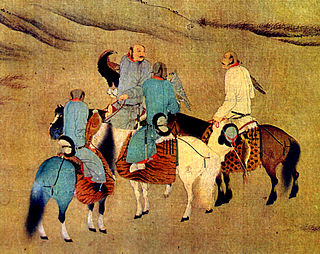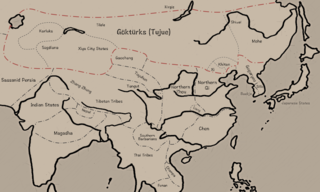
The Khitan people were a historical nomadic people from Northeast Asia who, from the 4th century, inhabited an area corresponding to parts of modern Mongolia, Northeast China and the Russian Far East.

This is the timeline of the Mongol Empire from the birth of Temüjin, later Genghis Khan, to the ascension of Kublai Khan as emperor of the Yuan dynasty in 1271, though the title of Khagan continued to be used by the Yuan rulers into the Northern Yuan dynasty, a far less powerful successor entity, until 1634.

The Liao dynasty, also known as the Khitan State, officially the Great Liao, was an imperial dynasty of China that existed between 916 and 1125, ruled by the Yelü clan of the Khitan people. Founded around the time of the collapse of the Tang dynasty, at its greatest extent it ruled over Northeast China, the Mongolian Plateau, the northern part of the Korean Peninsula, southern portions of the Russian Far East, and the northern tip of the North China Plain.

The military of the Tang dynasty was staffed with a large population of Turkic soldiers, referred to as Tujue (突厥) in Chinese sources. Tang elites in northern China were familiar with Turkic culture, a factor that contributed to the empire's acceptance of Turkic recruits. The Emperor Taizong of Tang adopted the title of "Heavenly Khagan" and promoted a cosmopolitan empire. Turkic soldiers that served under the Tang dynasty originated from the Eastern Turkic Khaganate. It began with Taizong who sent his general Li Jing, eventually ended in defeating the Eastern Turks and capturing their leader Jiali Khan.

This is a timeline of the Tang dynasty. Information on areas and events relevant to the Tang dynasty such as the Wu Zhou interregnum, when Wu Zetian established her own dynasty, and other realms such as the Sui dynasty, Tibetan Empire, Nanzhao, the Three Kingdoms of Korea, Japan, and steppe nomads are also included where necessary.
The siege of Lüshun was a military conflict between the Later Jin and Ming dynasty. In the summer of 1634 the Jin attacked and conquered the port city of Lüshun from Ming.

This is a timeline of the Göktürks from the origins of the Turkic Khaganate to the end of the Second Turkic Khaganate.

This is a timeline of the Jurchens.

This is a timeline of the Song dynasty (960–1279). The Song dynasty was founded by Zhao Kuangyin, posthumously known as Emperor Taizu of Song, who ended the period of division known as the Five Dynasties and Ten Kingdoms period. The Song dynasty is commonly separated into two historical periods, the Northern Song (960–1127) and the Southern Song (1127–1278), divided by the loss of the north to the Jurchen Jin dynasty (1115–1234). In 1279, the Mongol Yuan dynasty conquered the Song.

This is a timeline of the Five Dynasties and Ten Kingdoms (907–979), which followed the collapse of the Tang dynasty in 907 AD. The Five Dynasties refer to the succession of dynasties which ruled northern China following the Tang collapse while the Ten Kingdoms, with the exception of Northern Han, ruled in southern China. This era of division ended in 979 AD with the rise of the Song dynasty under Emperor Taizu of Song, although the Song would never reconquer the northern territory lost to the Khitans, collectively known as the Sixteen Prefectures.

This is a timeline of the Tangut people and the Western Xia dynasty.

This is a timeline of Mongols prior to the Mongol Empire.

This is a timeline of the Ilkhanate.

This is a timeline of the Chagatai Khanate (1226–1348) and its successor states, Moghulistan (1347–1462), Yarkent Khanate (1514–1696), and the Turpan Khanate (1462–1680).

This is a timeline of events involving the Golden Horde (1242–1502), from 1459 also known as the Great Horde.

Yunnan under Ming rule refers to the rule of the Ming dynasty in Yunnan, which saw the continuation of the tusi system instituted during the Yuan dynasty, increasing centralization, and Han migration into Yunnan.

This is a timeline of the Qing dynasty (1644–1912).

The Jurchen unification were a series of events in the late 16th and early 17th centuries that led to the unification of the Jurchen tribes under the Jianzhou Jurchen leader Nurhaci. While Nurhaci was originally a vassal of the Ming dynasty who considered himself a local representative of imperial Ming power, he also had a somewhat antagonistic relationship with the Ming due to Ming's involvement in events early on in his life that led to the death of his father and grandfather combined with his own increasing ambition.

This is a timeline of the Xinjiang under the rule of the Qing dynasty.

This is a timeline of the Era of Fragmentation, the period of Tibetan history lasting from the death of the Tibetan Empire's last emperor, Langdarma, in 842 until Drogön Chögyal Phagpa gained control over the three provinces of Tibet in 1253 under Mongol rule.




















